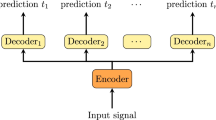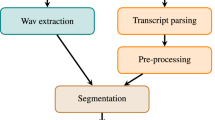Abstract
To investigate whether “Intelligence is the capacity of an information-processing system to adapt to its environment while operating with insufficient knowledge and resources" [29], we look at utilising the non axiomatic reasoning system (NARS) for speech recognition. This article presents NUTS: raNdom dimensionality redUction non axiomaTic reasoning few Shot learner for perception. NUTS consists of naive dimensionaility reduction, some pre-processing, and then non axiomatic reasoning (NARS). With only 2 training examples NUTS performs similarly to the Whisper Tiny model for discrete word identification.
Access this chapter
Tax calculation will be finalised at checkout
Purchases are for personal use only
Similar content being viewed by others
Notes
- 1.
For Narsese see https://cis.temple.edu/~pwang/NARS-Intro.html.
- 2.
A grid search showed 4 dimensions was reasonable.
- 3.
Whisper leverages language models greatly improving multiword performance.
References
de Andrade, D.C., Leo, S., Viana, M., Bernkopf, C.: A neural attention model for speech command recognition. ArXiv abs/1808.08929 (2018)
Arendt, D., Tosches, M., Marlow, H.: From nerve net to nerve ring, nerve cord and brain evolution of the nervous system. Nat. Rev. Neurosci. 17, 61–72 (2016). https://doi.org/10.1038/nrn.2015.15
Barsalou, L.W.: Perceptual symbol systems. Behav. Brain Sci. (1999). https://doi.org/10.1017/S0140525X99002149
Blazek, P.J., Lin, M.M.: Explainable neural networks that simulate reasoning. Nat. Comput. Sci. 1(9), 607–618 (2021)
Bloom, P.: How Children Learn the Meanings of Words. MIT press, Cambridge (2002)
Chalmers, D.J., French, R.M., Hofstadter, D.R.: High-level perception, representation, and analogy: a critique of artificial intelligence methodology. J. Exp. Theor. Artif. Intell. 4(3), 185–211 (1992). https://doi.org/10.1080/09528139208953747
Chen, Z., Bei, Y., Rudin, C.: Concept whitening for interpretable image recognition. Nat. Mach. Intell. 2(12), 772–782 (2020). https://doi.org/10.48550/arXiv.2002.01650
Durisek, P.: Speech recognition using nars (2014). https://www.applied-nars.com/articles/speech-recognition-using-nars
Fodor, J.A.: The Modularity of Mind. MIT press, Cambridge (1983). https://doi.org/10.7551/mitpress/4737.001.0001
Goldstone, R.L., Barsalou, L.W.: Reuniting perception and conception. Cognition 65(2–3), 231–262 (1998). https://doi.org/10.1016/s0010-0277(97)00047-4
Hammer, P.: Adaptive Neuro-Symbolic Network Agent, pp. 80–90. Springer, Heidelberg (2019). https://doi.org/10.1007/978-3-030-27005-6_8
Hammer, P., Lofthouse, T., Wang, P.: The OpenNARS implementation of the non-axiomatic reasoning system. In: Steunebrink, B., Wang, P., Goertzel, B. (eds.) AGI -2016. LNCS (LNAI), vol. 9782, pp. 160–170. Springer, Cham (2016). https://doi.org/10.1007/978-3-319-41649-6_16
Jarvilehto, T.: Efferent influences on receptors in knowledge formation. Psycoloquy 9(1) (1998)
Johansson, R.: Scientific progress in agi from the perspective of contemporary behavioral psychology. In: NARS AGI 2020 Workshop, 2020 (2020)
Johansson, R., Lofthouse, T., Hammer, P.: Generalized identity matching in nars. In: Artificial General Intelligence. Springer, Heidelberg (2022). https://doi.org/10.1007/978-3-031-19907-3_23
Lakoff, G., Johnson, M.: Philosophy in the flesh, the embodied mind and its challenge to western thought (1999). https://doi.org/10.1590/S0102-44502001000100008
Legg, S.: A review of “on defining artificial intelligence." J. Artif. General Intell. 11(2), 45–46 (2020). https://doi.org/10.2478/jagi-2019-0003
Lenat, D., Guha, R.V.: Cyc: a midterm report. AI Maga. 11(3), 32–32 (1990). https://doi.org/10.1609/aimag.v11i3.842
Li, C.: Openai’s gpt-3 language model: A technical overview. blog (2020). https://lambdalabs.com/blog/demystifying-gpt-3
Marra, G., Diligenti, M., Giannini, F., Maggini, M.: Learning representations for sub-symbolic reasoning. ArXiv abs/2106.00393 (2021).arXiv:2106.00393v2
Marra, G., Giannini, F., Diligenti, M., Gori, M.: Integrating learning and reasoning with deep logic models. In: Brefeld, U., Fromont, E., Hotho, A., Knobbe, A., Maathuis, M., Robardet, C. (eds.) ECML PKDD 2019. LNCS (LNAI), vol. 11907, pp. 517–532. Springer, Cham (2020). https://doi.org/10.1007/978-3-030-46147-8_31
Prinz, J.: Is the mind really modular. Contemp. Debates Cogn. Sci. 14, 22–36 (2006)
Project, P.: The Essential Peirce, Volume 2: Selected Philosophical Writings (1893–1913). Essential Peirce. Indiana University Press, Bloomington (1998)
Radford, A., Kim, J.W., Xu, T., Brockman, G., McLeavey, C., Sutskever, I.: Robust speech recognition via large-scale weak supervision. Technical report, OpenAI (2022). https://doi.org/10.48550/arXiv.2212.04356
Sejnowski, T.J.: The unreasonable effectiveness of deep learning in artificial intelligence. Proc. Natl. Acad. Sci. 117(48) (2020). https://doi.org/10.1073/pnas.1907373117
Shanahan, M.: Perception as abduction: turning sensor data into meaningful representation. Cogn. Sci. 29(1), 103–134 (2005). https://doi.org/10.1207/s15516709cog2901_5
Shimojo, S., Shams, L.: Sensory modalities are not separate modalities: plasticity and interactions. Curr. Opinion Neurobiol. 11(4), 505–509 (2001). https://doi.org/10.1016/s0959-4388(00)00241-5
Tosches, M.A., Arendt, D.: The bilaterian forebrain: an evolutionary chimaera. Curr. Opin. Neurobiol. 23(6), 1080–1089 (2013). https://doi.org/10.1016/j.conb.2013.09.005
Wang, P.: Non-axiomatic reasoning system: exploring the essence of intelligence. Indiana University (1995)
Wang, P.: On defining artificial intelligence. J. Artif. Gener. Intell. 10(2), 1–37 (2019). https://doi.org/10.2478/jagi-2019-0002
Wang, P., Hahm, C., Hammer, P.: A model of unified perception and cognition. Front. Artif. Intell. 5 (2022). https://doi.org/10.3389/frai.2022.806403
Wang, P., Hofstadter, D.: A logic of categorization. J. Exp. Theor. Artif. Intell. 18(2), 193–213 (2006). https://doi.org/10.1080/09528130600557549
Warden, P.: Speech commands: a dataset for limited-vocabulary speech recognition. arXiv preprint arXiv:1804.03209 (2018). https://doi.org/10.48550/arXiv.1804.03209
Acknowledgement
We thank reviewers and Parker Lamb for their comments.
Author information
Authors and Affiliations
Corresponding author
Editor information
Editors and Affiliations
1 Electronic supplementary material
Below is the link to the electronic supplementary material.
Rights and permissions
Copyright information
© 2023 The Author(s), under exclusive license to Springer Nature Switzerland AG
About this paper
Cite this paper
van der Sluis, D. (2023). NUTS, NARS, and Speech. In: Hammer, P., Alirezaie, M., Strannegård, C. (eds) Artificial General Intelligence. AGI 2023. Lecture Notes in Computer Science(), vol 13921. Springer, Cham. https://doi.org/10.1007/978-3-031-33469-6_31
Download citation
DOI: https://doi.org/10.1007/978-3-031-33469-6_31
Published:
Publisher Name: Springer, Cham
Print ISBN: 978-3-031-33468-9
Online ISBN: 978-3-031-33469-6
eBook Packages: Computer ScienceComputer Science (R0)




